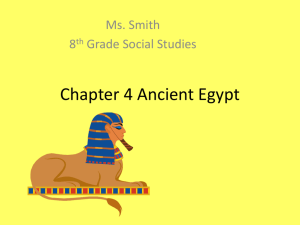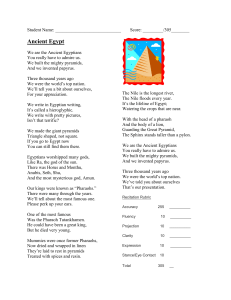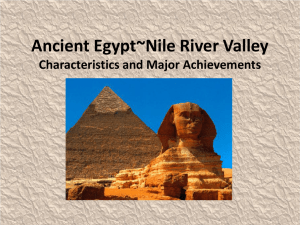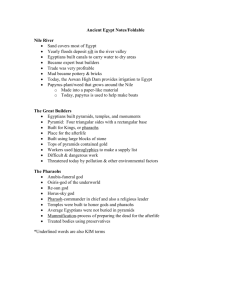Ancient Egypt Unit Test (REVISED) - Ashley Jones
advertisement
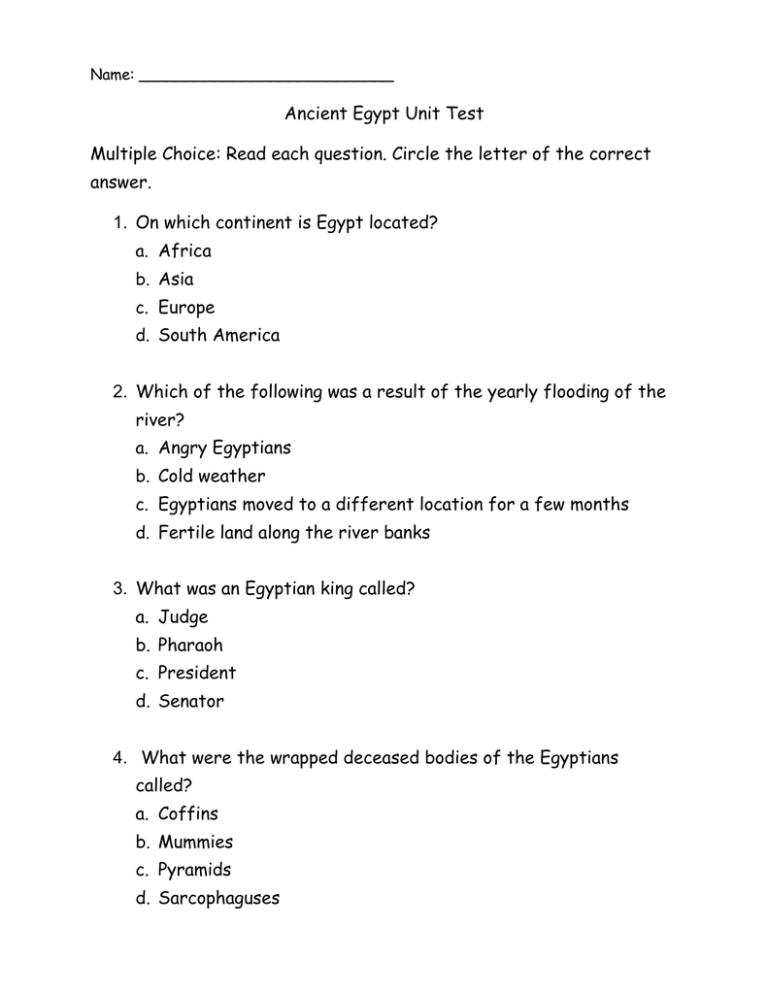
Name: ___________________________ Ancient Egypt Unit Test Multiple Choice: Read each question. Circle the letter of the correct answer. 1. On which continent is Egypt located? a. Africa b. Asia c. Europe d. South America 2. Which of the following was a result of the yearly flooding of the river? a. Angry Egyptians b. Cold weather c. Egyptians moved to a different location for a few months d. Fertile land along the river banks 3. What was an Egyptian king called? a. Judge b. Pharaoh c. President d. Senator 4. What were the wrapped deceased bodies of the Egyptians called? a. Coffins b. Mummies c. Pyramids d. Sarcophaguses 5. How many days did it take for mummification? a. 2 b. 35 c. 70 d. 365 6. Which two words describe the climate of Egypt? a. Hot and dry b. Hot and wet c. Cold and dry d. Cold and wet 7. The ancient Egyptian writing system used pictures and symbols. What is the name of this form of writing? a. Calendar b. Graphics c. Hieroglyphics d. Picture graphs True or false: Write true or false on the line. 8. Is this statement true or false? King Tut’s tomb was discovered in the Valley of Kings. _____ 9. Look at the map below. Which number identifies Egypt? ______ 10 Many ancient Egyptians lived close to the Nile River. The Nile River was the center of life in ancient Egypt. Why did most ancient Egyptians live near the Nile River? Write three sentences to give three different ways ancient Egyptians used the Nile River. _____________________________________________________ _____________________________________________________ _____________________________________________________ _____________________________________________________ _____________________________________________________ _____________________________________________________ _____________________________________________________ Read each definition. Select the letter that best matches each definition, and write the letter in the blank beside the definition. a. delta b. desert c. fertile land d. flooding e. mine f. mountain g. Nile River h. oasis i. quarries 11 ____ Hot place full of sand and dunes, natural barrier between ancient Egypt and invading foreign armies 12 ____ Receding flood waters left a narrow strip of land on the banks of the Nile that was good for growing crops. 13 ____ The center of life in ancient Egypt, provided the ancient Egyptians with many of their needs 14 ____ The Nile runs through the desert plain out to the Mediterranean sea. Just before it reaches the sea it separates out into several small branches, creating this marshy land 15 ____ An area of land in the middle of a desert with a natural water source 16 ____ A place from which Egyptians took stone to build statues and temples 17 ____ A place from which ancient Egyptians took gold to make jewelry and special objects for the pharaoh and his family, members of the nobility, and temples Read each paragraph below and answer the questions using the information from the paragraphs. Temples The ancient Egyptians believed that temples were the homes of the gods and goddesses. Every temple was dedicated to a god or goddess and he or she was worshipped there by the temple priests and the pharaoh. The large temple buildings were made of stone so that they would last forever. Their walls were covered with scenes that were carved onto the stone then brightly painted. These scenes showed the pharaoh fighting in battles and performing rituals with the gods and goddesses. 18 Who worshipped the gods and goddesses at the temples? ______________________and ________________________ 19 Describe the walls of the temples. _____________________________________________________ _____________________________________________________ Pyramids The pyramids are the stone tombs of Pharaohs and one of the world’s greatest historical mysteries. They have stood for thousands of years, filled with many hidden secrets. They give us clues about what life and death was like in ancient Egypt. The Egyptians believed that if the pharaoh’s body could be mummified after death the pharaoh would live forever. The tombs were designed to protect the buried Pharaoh’s body and his belongings. 20 Explain why the pyramids were designed. _____________________________________________________ _____________________________________________________ Answer Key 1. A 2. D 3. B 4. B 5. C 6. A 7. C 8. TRUE 9. 5 10. It provided them with food. It provided them with water. They used it for transporting goods and people. 11. B 12. C 13. G 14. A 15. H 16. L 17. E 18. Temple priests and pharaohs 19. Their walls were covered with scenes that were carved onto the stone then brightly painted. These scenes showed the pharaoh fighting in battles and performing rituals with the gods and goddesses. 20. The tombs were designed to protect the buried Pharaoh’s body and his belongings.
